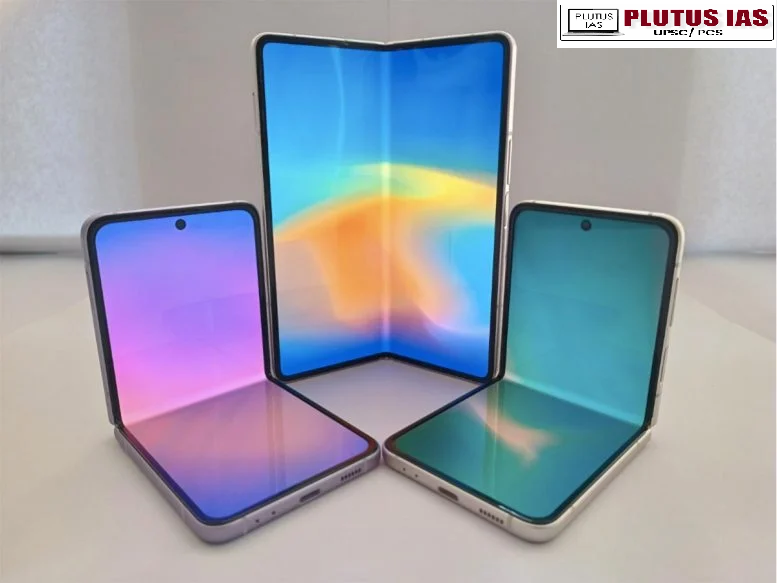02 May Organic LEDs (OLEDs): A Breakthrough in Modern Display Solutions
This article covers “Daily Current Affairs” and the Topic of Organic LEDs (OLEDs): A Breakthrough in Modern Display Solutions
SYLLABUS MAPPING:
GS-3- Science and Technology- Organic LEDs (OLEDs): A Breakthrough in Modern Display Solutions
FOR PRELIMS
What is Organic Light-Emitting Diodes (OLEDs)? and comparisons between LED and OLEDs
FOR MAINS
What are the applications of Organic Light-Emitting Diodes (OLEDs)?
Why in the News?
Organic Light-Emitting Diodes (OLEDs) are in the news due to their rising use in advanced display technologies such as foldable smartphones, ultrathin televisions, and flexible screens. These devices leverage OLEDs for their key advantages, including self-illumination, ultra-thin and flexible design, high contrast ratios, vibrant color reproduction, lightweight structure, and energy-efficient operation. Recent developments in material science and nanotechnology have further enhanced the appeal of OLEDs, making them a preferred choice over traditional LCD and LED technologies. However, the multilayer structure of OLEDs, while essential for efficient charge transport and light emission, also leads to gradual degradation of the organic layers over time. This degradation remains a major challenge, limiting both the lifespan and efficiency of OLED devices.

What is Organic Light-Emitting Diodes (OLEDs)
Organic Light-Emitting Diodes (OLEDs) are display and lighting devices made from organic (carbon-based) materials that emit light when electricity is applied. They are self-illuminating, meaning they do not require a backlight. OLEDs consist of thin organic layers sandwiched between two electrodes. When voltage is applied, electrons and holes recombine to emit light. They offer flexibility, high contrast, and vivid colour reproduction. OLEDs are widely used in modern smartphones, TVs, and wearable electronics.
Organic Light-Emitting Diodes vs Light Emitting Diodes
| Feature | OLED (Organic LED) | LED (Light Emitting Diode) |
|---|---|---|
| Material | Organic compounds | Inorganic semiconductors (e.g., gallium arsenide) |
| Light Source | Self-emissive; each pixel emits its own light | Requires a backlight for display (in LED TVs) |
| Flexibility | Flexible, can be bent or folded | Rigid, not easily flexible |
| Thickness | Ultra-thin and lightweight | Thicker due to additional layers and backlighting |
| Contrast and Viewing Angle | High contrast and wide viewing angles | Lower contrast and limited viewing angles |
| Power Efficiency | More efficient for dark displays | More efficient for bright displays |
| Applications | Smartphones, foldable displays, high-end TVs, wearables | Traditional lighting, LED TVs, indicators, and display panels |
| Cost | Expensive due to complex materials and manufacturing | Cheaper and widely available |
Organic Light-Emitting Diodes (OLEDs) Applications
1. Smartphones and Tablets: OLEDs provide high contrast, vibrant colours, and flexible, ultra-thin designs, enhancing battery efficiency in mobile devices.
2. Televisions: Used in premium TVs for superior picture quality, deep blacks, and wide viewing angles.
3. Wearable Electronics: OLEDs are ideal for smartwatches and fitness trackers due to their thin, flexible nature.
4. Flexible Displays: OLEDs enable foldable, rollable, and curved screens, revolutionising modern device designs.
5. Automotive Displays: OLEDs are used in dashboards, infotainment systems, and ambient lighting for vehicles.
6. Lighting: Efficient for large, uniform light panels in architectural and decorative lighting systems.
7. Virtual and Augmented Reality: OLEDs offer fast response times, high refresh rates, and vibrant colours for immersive VR and AR experiences.
8. Digital Signage: Used in dynamic advertising displays, billboards, and storefront windows for vivid, high-quality visuals.
9. Medical Displays: OLEDs are used in medical imaging equipment for clear, high-contrast diagnostic screens.
10. Projectors: OLEDS are utilized in projectors for bright, high-quality images with excellent colour accuracy.
Conclusion
Organic Light-Emitting Diodes (OLEDs) represent a significant breakthrough in modern display technologies, offering unique advantages such as flexibility, high contrast ratios, energy efficiency, and vivid color reproduction. Their self-emissive nature allows for ultra-thin designs, making them ideal for advanced devices like foldable smartphones and ultrathin televisions. Despite their promising benefits, the challenges of material degradation and limited lifespan remain key hurdles. As research in material science and nanotechnology continues, OLEDs are expected to evolve, leading to enhanced durability, efficiency, and broader applications in consumer electronics and lighting solutions. The ongoing advancements in OLED technology not only mark a milestone in display innovation but also pave the way for the next generation of ultra-thin, flexible, and energy-efficient devices.
Source: https://scitechdaily.com/revolutionizing-oleds-new-spectroscopy-technique-extends-device-lifespan/
Download Plutus IAS Current Affairs (Eng) 2nd May 2025
Prelims Questions
Q. Which of the following statements is/are correct concerning Organic Light-Emitting Diodes (OLEDs)?
1. OLEDs are self-emissive, meaning they do not require a backlight to produce light.
2. OLEDs are made from inorganic semiconductors such as gallium arsenide, similar to traditional LEDs.
Select the correct answer using the code given below:
A. 1 only
B. 2 only
C. Both 1 and 2
D. Neither 1 nor 2
Answer: A
Mains Questions
Q. Organic Light-Emitting Diodes (OLEDs) represent a revolutionary step in display technology. However, despite their advantages, they face several challenges.” Discuss the potential of OLEDs in modern display solutions and the challenges limiting their widespread use
(250 words, 15 marks)




No Comments